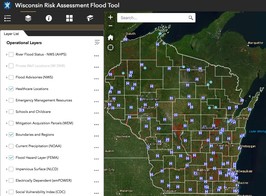

New and Updated Data Available!
We recently added several new topics to our data portal and updated data for existing topics. Data are available at the county level, and some measures include data at the census tract level.
New Data Topics:
-
Adult Blood Lead Poisoning—data on prevalent cases (number and rate of all adults with blood lead levels at or over 5, 10, 25, and 40 µg/dL) and incident cases (number and rate of adults newly recorded for the year with blood lead levels at or over 5, 10, 25, and 40 µg/dL). Data are available for 2019.
-
Extreme Heat Projections—data on the projected number of future extreme heat days and projected number of future extreme heat nights.
-
Extreme Precipitation Projections—data on projected annual precipitation intensity, projected number of future extreme precipitation days, ratio of projected precipitation falling as rain to that falling as snow.
Updated Existing Topics:
-
Alcohol data—updated with 2017 and 2018 hospitalizations and outlet density.
-
Asthma data—updated with 2018 and 2019 inpatient hospitalization and emergency department visits data.
-
Birth defects data—updated to include data through 2014–2018
-
Lyme disease data—updated to include data through 2019
-
Oral health data—updated with 2018 and 2019 Medicaid data and 2017–2018 third grade survey data
Please let us know if you have any questions. Happy Tracking!
|

Climate and Health Program tools help communities plan, respond to floods
The Climate and Health Program offers a suite of tools to help local communities prepare for and respond to floods. Whether you work in local or tribal public health, emergency management, regional planning, or flood management, these tools will help!
The Department of Health Services (DHS) teamed up with Wisconsin Sea Grant to develop the Flood Resilience Scorecard, a comprehensive flood planning tool for local government that assesses flood readiness through three lenses: landscape characteristics, sustainable policies and plans, and social vulnerability. The Risk Assessment Flood Tool (RAFT) integrates 32 flood-related spatial data layers in one customizable ArcGIS map, and the Wisconsin Flood Toolkit provides guidance on managing the health and safety aspects of flood events, including information for the public in English and Spanish.
For more information, contact the Climate and Health Program at 608-267-3242 or DHSCLIMATE@dhs.wisconsin.gov.
|

Lyme Disease Trends in Wisconsin Surveillance Brief Updated
Ticks will be out before we know it! Check out your county's rate of Lyme disease in Wisconsin Tracking Program's Lyme Disease Trends in Wisconsin surveillance brief. It has been updated to include 2018 data.
Webinar: Information Systems to Advance Environmental Justice
The Wisconsin Tracking Program participated in an EPA webinar on the topic of Information Systems to Advance Environmental Justice on September 10, 2020. The recording of this webinar is now available. This webinar is part of the EPA State Environmental Justice Training Webinar Series to build the long-term capacity of practitioners working to advance environmental justice at the state level.
This webinar examined in-depth information sources that can be used for analyzing environmental and public health impacts. It also highlighted the importance of having refined information on environmental emissions and exposures, health effects, and social determinants of health available in order to advance environmental justice.
2021-2025 Wisconsin Asthma Plan Released
In 2003, the first Wisconsin Asthma Plan was adopted to provide the blueprint for addressing asthma as a public health priority, and listed the prioritized goals, objectives, and activities recommended for statewide action to reduce the burden of asthma in Wisconsin. The updated 2021-2015 plan has been reorganized to reflect the need for asthma education across the continuum of care.
|